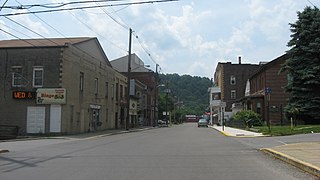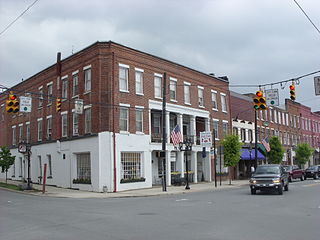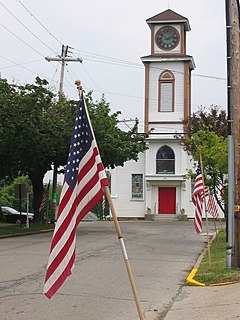
Wilkes-Barre is a city in the U.S. state of Pennsylvania and the county seat of Luzerne County. Located at the center of the Wyoming Valley, it had a population of 44,328 in the 2020 census. It is the second-largest city of the Scranton–Wilkes-Barre–Hazleton, PA Metropolitan Statistical Area, which had a population of 563,631 as of the 2010 Census and is the fourth-largest metropolitan area in Pennsylvania after the Delaware Valley, Greater Pittsburgh, and the Lehigh Valley.

Luzerne County is a county in the Commonwealth of Pennsylvania. The county has a total area of 906 square miles (2,350 km2) of which 890 square miles (2,300 km2) is land and 16 square miles (41 km2) is water, according to the U.S. Census Bureau. It is Northeastern Pennsylvania's second-largest county by total area and Northeast Pennsylvania's most populous county, with a population of 325,594 as of the 2020 census.

Hanover Township is a township in Luzerne County, Pennsylvania, United States. As of the 2010 census, the population was 11,076, making it the most populous township in the county.

The Wyoming Valley is a historic industrialized region of Northeastern Pennsylvania, historically notable for fueling the American Industrial Revolution in the United States with its many anthracite coal-mines. As a metropolitan area, it is known as the Scranton/Wilkes-Barre metropolitan area, after its principal cities, Scranton and Wilkes-Barre. With a population of 567,559 as of the 2020 United States census, it is the fifth-largest metropolitan area in Pennsylvania, after the Delaware Valley, Greater Pittsburgh, the Lehigh Valley, and the Harrisburg–Carlisle metropolitan statistical areas.

Northeastern Pennsylvania (NEPA) is a geographic region of the U.S. state of Pennsylvania that includes the Pocono Mountains, the Endless Mountains, and the industrial cities of Scranton, Wilkes-Barre, Pittston, Hazleton, Nanticoke, and Carbondale. A portion of this region constitutes a part of the New York City metropolitan area.

The Hinton Historic District is a national historic district located at Hinton, Summers County, West Virginia. The original Hinton Historic District is bordered roughly by the Chesapeake and Ohio Railroad line, James Street, 5th Avenue, and Roundhouse. The boundary increase extended the district to include Mill Street. It was listed on the National Register of Historic Places in 1984 and revised in 2005.

Forty Fort Meetinghouse is a historic meeting house at River Street and Wyoming Avenue in the Old Forty Fort Cemetery in Forty Fort, Luzerne County, Pennsylvania. It was built in 1806–08 in a New England meeting house style with white clapboard siding and was added to the National Register of Historic Places in 1988.

Harry Livingston French was an American architect based in Wilkes-Barre, Pennsylvania. He designed in a variety of styles, including classical architecture and Gothic revival. His built works included numerous banks, schools, and armories.
Charles Ives Barber was an American architect, active primarily in Knoxville, Tennessee, and vicinity, during the first half of the 20th century. He was cofounder of the firm, Barber & McMurry, through which he designed or codesigned buildings such as the Church Street Methodist Episcopal Church, South, the General Building, and the Knoxville YMCA, as well as several campus buildings for the University of Tennessee and numerous elaborate houses in West Knoxville. Several buildings designed by Barber have been listed on the National Register of Historic Places.

Mullens Historic District is a national historic district located at Mullens, Wyoming County, West Virginia. It encompasses 95 contributing buildings and one contributing structure in the central business district of Mullens. It also includes surrounding residential areas. Notable buildings include the Highlawn Baptist Church (1925), Old Presbyterian Church, Wyoming Hotel (1918), Bank of Mullens Building (1920), Masonic Hall Building (1924), Welch Apartment Building, Old Hospital / Webster Apartments, Smiley Department Store Building (1921), Piggly Wiggly Building (1929), Wyoming Theatre (1922), and Norfolk Southern Locomotive Repair Shop Building (1925).

Williamsburg Historic District is a national historic district located at Williamsburg, Blair County, Pennsylvania. The district includes 362 contributing buildings and 6 contributing structures in the central business district and surrounding residential areas of Williamsburg. The earliest buildings date to the 1830s, when the community was expanded as a canal town along the Pennsylvania Main Line Canal. The buildings are primarily frame and brick, with notable examples of Federal and Late Victorian style architecture. Notable non-residential buildings include the Schwab Hotel, Hollidaysburg Trust Company (1873), Presbyterian Church (1841), Zion Lutheran Church (1907), Church of the Brethren (1911), Williamsburg High School (1918), and Community Elementary School (1941). Also located in the district are Presbyterian, Methodist, Lutheran, and Lutheran and German Reformed cemeteries; Big Spring; and the Pennsylvania Main Line Canal and Pennsylvania Railroad right-of-way.

Moxham Historic District is a national historic district located at Johnstown in Cambria County, Pennsylvania. The district includes 330 contributing buildings in a predominantly residential area in southern Johnstown. There are 315 contributing dwellings, 17 former carriage house / horse barns, 21 commercial buildings, 10 churches, and one former school. The district includes five contributing buildings dated before the Johnstown Flood, but the majority date from 1890 to 1930. The dwellings include notable examples of popular architectural styles including Bungalow/craftsman, Colonial Revival, and American Foursquare. Notable non-residential buildings include St. Patrick's Catholic Church (1905), former Calvary Methodist Church (1894), Allegheny Wesleyan Methodist Church (1898), Grove Avenue Methodist Church (1902), Second Presbyterian Church (1914), and former Cypress Avenue School (1900).

Mercersburg Historic District is a national historic district centered on the center square of Mercersburg in Franklin County, Pennsylvania. The district includes 124 contributing buildings and 1 contributing site in the central business district and surrounding residential areas of Mercersburg. The residential buildings include a number of sheathed log, stone, and brick dwellings, with some dating to the 18th century. The district has a number of notable examples of the Federal, Greek Revival, and Colonial Revival styles.

Emlenton Historic District is a national historic district located at Emlenton, Venango County, Pennsylvania. The district includes 317 contributing buildings, 57 contributing structures, and 1 contributing object in the central business district and surrounding residential areas of Emlenton. It includes commercial, residential, industrial, and institutional buildings. They are in a variety of popular architectural styles including Italianate, Greek Revival, and Gothic Revival.

Tunkhannock Historic District is a national historic district located at Tunkhannock, Wyoming County, Pennsylvania. It encompasses 225 contributing buildings in the central business district and surrounding residential areas of Tunkhannock. The district includes residential, commercial, and institutional buildings constructed between 1841 and 1954, in a variety of popular architectural styles including Queen Anne and Italianate. Notable buildings include the Bolles-Bardwell-Tewksbury Building, Prince Hotel (1844), Phelps Building (1844-1845), Dietrich Theater (1925), former Masonic Hall, Stark Block, Wyoming County Courthouse, Palen-Ervine House (1868), Piatt-Ogden House (1896), Presbyterian Church of Tunkhannock (1891), and First United Methodist Church (1934).

Saxonburg Historic District is a national historic district located at Saxonburg, Butler County, Pennsylvania. The district includes 54 contributing buildings and 2 contributing objects in the central business district and surrounding residential area of Saxonburg. It includes residential, commercial, and institutional buildings built between 1831 and 1952 in a number of popular architectural styles including Greek Revival and Gothic Revival. The original town was laid out in 1831 by noted civil engineer John A. Roebling. Notable buildings include the Helmbold House, Hotel Saxonburg, Kuntz-Steubgen House, Maurhoff Building, Kornfelder Building, St. Luke's Lutheran Church, and the Memorial United Presbyterian Church. Located in the district and listed separately is the John Roebling House.

Saluda Main Street Historic District is a national historic district located at Saluda, Polk County, North Carolina. The district encompasses 16 contributing buildings, 1 contributing site, and 1 contributing structure in the central business district of Saluda. It includes buildings dated from about 1878 to 1946 and notable examples of Late Gothic Revival and Stick style / Eastlake movement architecture. Notable buildings include the Saluda Presbyterian Church (1895-1896), former Saluda Depot, the Saluda City Hall (1896-1907), the M. A. Pace Store (1905-1910), Thompson's Store (1905-1910), Pebbledash Building (1911-1916), Top Service Station (1930s), and the former United States Post Office.

Crown Heights North Historic District is a national historic district located in the Crown Heights neighborhood of Brooklyn, Kings County, New York. The district encompasses 1,019 contributing buildings in a predominantly residential section of Brooklyn. The district features noteworthy examples of Greek Revival, Gothic Revival, Italianate, Second Empire, Queen Anne, Romanesque Revival, Renaissance Revival, Beaux-Arts, and Colonial Revival style architecture. It largely developed between about 1853 and 1942, and consists of densely constructed rowhouses, townhouses, two-family houses, semi-attached houses, freestanding houses, flats, apartment buildings, and institutional and commercial buildings.

Holley Village Historic District is a national historic district located at Holley, Orleans County, New York. The district encompasses 40 contributing buildings, 1 contributing site, and 1 contributing object in the central business district of the village of Holley. The district developed between about 1822 and 1952, and includes buildings in a variety of architectural styles including Greek Revival, Italianate, Queen Anne, Beaux Arts, and Late Gothic Revival. Notable contributing resources include the Public Square and Salisbury Fountain (1914), First Presbyterian Church, White-Alis Building, Village Building, Rutland Block/Lockwood Building/Community Library (1896), Odd Fellows Hall (1890), Downs Residence, St. Mary's Roman Catholic Church (1904-1905), Downs Hotel/Hotel Holley designed by Andrew Jackson Warner, Village Building and Holley Standard, First Methodist Episcopal Church (1868-1869), and the Holley High School (1930-1931).

West LaSalle Avenue Historic District is a national historic district located at South Bend, St. Joseph County, Indiana. It encompasses 33 contributing buildings and 2 contributing structures in a predominantly residential section of South Bend. It developed between about 1870 and 1930, and includes notable examples of Italianate, Queen Anne, Late Gothic Revival, and Beaux-Arts style architecture and works by architects Austin & Shambleau. Notable buildings include the St. Peter's Church (1927), Frank Eby House (1904), Lydia Klinger House (1900), Woodworth House, Woolman House (1880), Goetz House (1892), Studebaker House, Kuppler House (1885), and the Gunderman House.
























